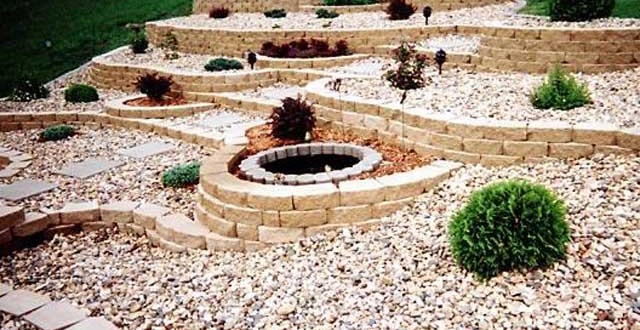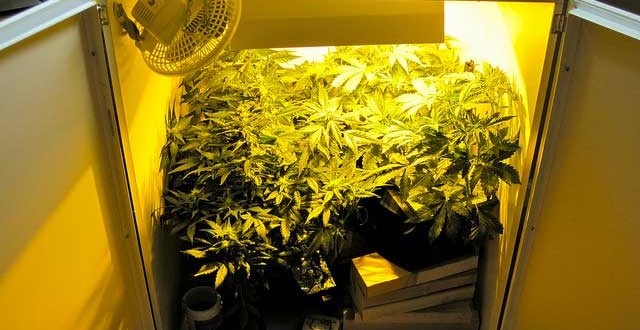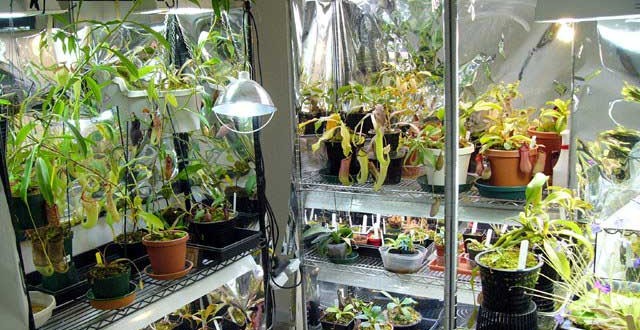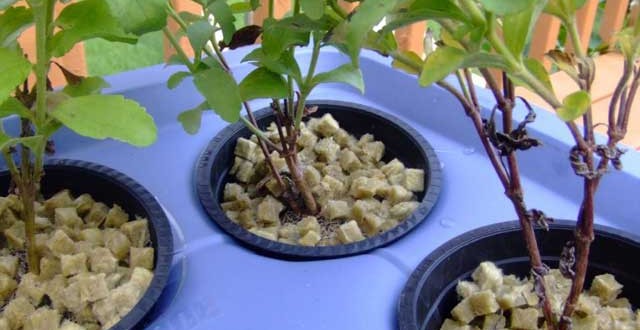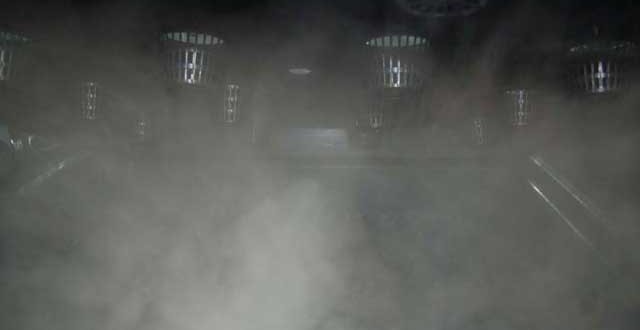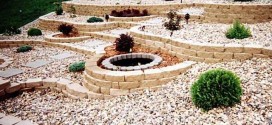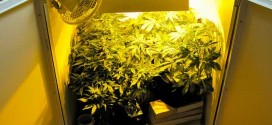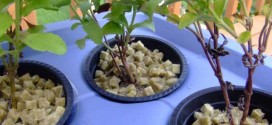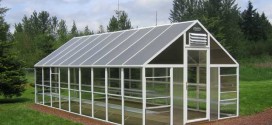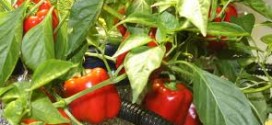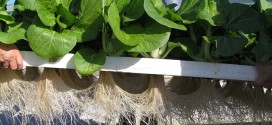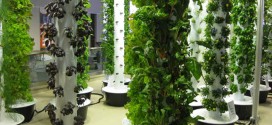Xeriscaping Xeriscaping and xerogardening refer to landscaping and gardening in ways that reduce or eliminate the need for supplemental water from irrigation. It is promoted in regions that do not have easily accessible, plentiful, or reliable supplies of fresh water, and is gaining acceptance in other areas as climate patterns shift. Although xeriscaping may be an alternative to various types of traditional gardening, it is usually promoted as a substitute for Kentucky bluegrass lawns. Kentucky blugrass is commonly used in American suburban landscaping. A cool-season grass, it is well suited to high foot traffic and recreation. However, it is difficult to grow in sandy or compacted soil as well as fast draining sites like slopes, especially those facing the sun. For these reasons, Kentucky bluegrass requires more water use than necessary in arid regions. The word xeriscaping is a portmanteau of xeros ξήρος (Greek for “dry”) and landscaping, and xeriscape is used for this style of garden. Xeriscaping refers to a method of landscape design that minimizes water use. Many Denver Water employees helped coin the term xeriscape, and Xeriscape and the xeriscape logo are registered trademarks of Denver Water, the water department of Denver, Colorado. In some areas, terms such as water-conserving landscapes, drought-tolerant landscaping, and smart scaping are used instead. Plants whose natural requirements are appropriate to the local climate are emphasized, and care is taken to avoid losing water to vaporation and run-off. The specific plants used in xeriscaping depend upon the climate. Xeriscaping is not the same as “zero-scaping” (in which the designed landscape consists mostly of hard surfaces, with a few plants as accent features), and can look quite lush and colorful. Xeriscaping is also different from natural landscaping, because the emphasis in xeriscaping is on selection of plants for water conservation, not necessarily selecting native plants. Advantages Cacti are one of the …
Read More »New Technologies
Grow box
Plants can be grown indoors year round using a grow box. A grow box is a partially or completely enclosed system for raising plants indoors or in small areas. Grow boxes are used for a number of reasons, including lack of available outdoor space or the desire to grow vegetables, herbs or flowers during cold weather months. They can also help protect plants against pests or disease. Grow boxes may be soil-based or hydroponic. The most sophisticated examples are totally enclosed, and contain a built-in grow light, intake and exhaust fan system for ventilation, hydroponics system that waters the plants with nutrient-rich solution, and an odor control filter. Some advanced grow box units even include air conditioning to keep running temperatures down, as well as CO2 to boost the plant’s growth rate. These advanced elements allow the gardener to maintain optimal temperature, light patterns, nutrition levels, and other conditions for the chosen plants. Key growlight options include fluorescent bulbs, which offer relatively limited light output; High Intensity Discharge (HID) bulbs such as High Pressure Sodium (HPS) and Metal Halide (MH); and Light-Emitting Diode (LED) bulbs, which are becoming more energy-efficient. In different sizes and degrees of complexity, grow boxes are also referred to as grow cabinets and stealth cabinets – the latter term is common when used to grow illegal plants, such as marijuana in the U.S. A full-room version of a grow box is a growroom. Important basic parts of grow cabinet Grow cabinets have many different pieces of equipment that improve plant growth and yields. The system, once all together, will usually allow its owner to control all conditions inside the cabinet to make them perfect for growth. Below is a chart of different pieces of equipment on many commercially-built cabinets. Names of Equipment Use/Benefits Types Carbon Filter – Prevents smells from escapinginto areas …
Read More »Growroom
A growroom (or grow room) is a room of any size where plants are grown under controlled conditions. The reasons for utilizing a growroom are countless. Some seek to avoid the criminal repercussions of growing illicit cultivars, while others simply have no alternative to indoor growing. Plants can be grown with the use of artificial light, sunlight, or a combination of the two. Due to the heat generated by high power lamps, grow rooms will often become excessively hot relative to the temperature range ideal for plant growth, often necessitating the use of a supplemental ventilation fan. Growing methods The plants in a growroom can be grown in soil, or without soil via means such as hydroponics, and aeroponics. Not only is growing in a soiless medium more cost effective, sometimes one also gets a much higher yield, as well as faster fruit maturation. Soiless mixes usually carry 0% nutrients so the gardener can utilize the perfect combination of nutrients for the crop. Vermiculite, perlite, coconut husk and rockwool are the most popular mixes for indoor cultivation. Lighting The three most common varieties of lighting for indoor growing are high-intensity discharge lamps (the most prevalent for this application being: sodium-vapor lamps for flowering and metal halide lamps for growing), compact fluorescent lamps, and traditional fluorescent lamps. Full spectrum indoor LED grow lights are becoming more common in grow rooms due to their low energy requirements and very low heat output. LED grow lights use very low power and are designed to optimize photosynthesis, as opposed to fluorescent lights which only provide a portion of the desirable spectrum or incandescent and gas-discharge bulbs which also produce only a portion of the optimal wavelengths and, in addition, waste significant energy in the form of heat. Luminous efficacy High Intensity discharge lamps (HID) have …
Read More »Organic Hydroponics
Organic hydroponics uses organic fertilizer. Conventional hydroponics cannot use organic fertilizer because organic compounds contained in hydroponic solution inhibit the growth of the crop roots, so it uses only inorganic fertilizer. In organic hydroponics, organic fertilizer is degraded into inorganic nutrients by microorganisms in the hydroponic solution via ammonification and nitrification. The microorganisms are cultured with a method of multiple parallel mineralization. The culture solution can be used as the hydroponic solution. Practical method of organic hydroponics is developed in National Agriculture and Food Research Organization (NARO), in Japan, in 2005. History of organic hydroponics Studies for establishing organic hydroponics have been conducted for long time. Kennedy Space Center had studied organic hydroponics for crop production in space. It was necessary to develop the method to generate nitrate from organic fertilizer via ammonification and nitrification, because most of crops are nitrate-phylic but not ammonium-philic. It is easy to generate ammonium from organic fertilizer by saprophytic microorganisms. However it was difficult to degrade organic fertilizer to nitrate efficiently because the growth of nitrifying bacteria, such as the obligate chemolithoautotrophs Nitrosomonas spp. and Nitrospira spp., is particularly inhibited by the presence of organic compounds (Jensen 1950; Quastel and Scholefield 1951; Rittenberg 1969; Smith and Hoare 1977; Krummel and Harms 1982; Takahashi et al. 1992; Stutte 1996; Xu et al. 2000; Tomiyama et al. 2001). Shinohara (1) invented the method to efficiently generate nitrate from in water. The method, multiple parallel mineralization, consists of three manipulations: small inoculation of soil microorganisms, addition of small amounts of organic fertilizer, and aeration. The mineralized solution can be used as the hydroponic solution and organic fertilizer can be added in the solution during cultivation. This is the first practical organic hydroponics technique that organic fertilizer can be added directly during cultivation.
Read More »Fogponics
Fogponics is an advanced form of aeroponics which uses water in a vaporised form to transfer nutrients and oxygen to enclosed suspended plant roots. Using the same general idea behind aeroponics except fogponics utilize a 5-30 µm mist within the rooting chamber and as use for a foliar feeding mechanism. Plants best absorb particles from the 1-25 µm range, the smaller particulate size means faster absorption. The added benefit of using fogponic’s over traditional hydroponics systems is that the plants require less energy in root growth and mass, and are able to still sustain a large plant. Trials using fogponics, have shown that water and energy use is reduced compared with traditional aeroponic and hydroponic systems, and that higher yields are achievable.
Read More »Greenhouse
A greenhouse (also called a glasshouse) is a building in which plants are grown. These structures range in size from small sheds to industrial-sized buildings. A miniature greenhouse is known as a cold frame. A greenhouse is a structural building with different types of covering materials, such as a glass or plastic roof and frequently glass or plastic walls; it heats up because incoming visible solar radiation (for which the glass is transparent) from the sun is absorbed by plants, soil, and other things inside the building. Air warmed by the heat from hot interior surfaces is retained in the building by the roof and wall. In addition, the warmed structures and plants inside the greenhouse re-radiate some of their thermal energy in the infrared spectrum, to which glass is partly opaque, so some of this energy is also trapped inside the glasshouse. However, this latter process is a minor player compared with the former (convective) process. Thus, the primary heating mechanism of a greenhouse is convection. This can be demonstrated by opening a small window near the roof of a greenhouse: the temperature drops considerably. This principle is the basis of the autovent automatic cooling system. Thus, the glass used for a greenhouse works as a barrier to air flow, and its effect is to trap energy within the greenhouse. The air that is warmed near the ground is prevented from rising indefinitely and flowing away. Although heat loss due to thermal conduction through the glass and other building materials occurs, net energy (and therefore temperature) increases inside the greenhouse. Types Greenhouses can be divided into glass greenhouses and plastic greenhouses. Plastics mostly used are polyethylene film and multiwall sheets of polycarbonate material, or PMMA acrylic glass. Commercial glass greenhouses are often high-tech production facilities for vegetables or flowers. The glass greenhouses are filled with equipment such …
Read More »Hydroponics
Hydroponics is a subset of hydroculture and is a method of growing plants using mineral nutrient solutions, in water, without soil. Terrestrial plants may be grown with their roots in the mineral nutrient solution only or in an inert medium, such as perlite, gravel, mineral wool, expanded clay or coconut husk. Researchers discovered in the 18th century that plants absorb essential mineral nutrients as inorganic ions in water. In natural conditions, soil acts as a mineral nutrient reservoir but the soil itself is not essential to plant growth. When the mineral nutrients in the soil dissolve in water, plant roots are able to absorb them. When the required mineral nutrients are introduced into a plant’s water supply artificially, soil is no longer required for the plant to thrive. Almost any terrestrial plant will grow with hydroponics. Hydroponics is also a standard technique in biology research and teaching. History The earliest published work on growing terrestrial plants without soil was the 1627 book Sylva Sylvarum by Francis Bacon, printed a year after his death. Water culture became a popular research technique after that. In 1699, John Woodward published his water culture experiments with spearmint. He found that plants in less-pure water sources grew better than plants in distilled water. By 1842, a list of nine elements believed to be essential to plant growth had been compiled, and the discoveries of the German botanists Julius von Sachs and Wilhelm Knop, in the years 1859-65, resulted in a development of the technique of soilless cultivation. Growth of terrestrial plants without soil in mineral nutrient solutions was called solution culture. It quickly became a standard research and teaching technique and is still widely used today. Solution culture is now considered a type of hydroponics where there is no inert medium. In 1929, William Frederick …
Read More »Aquaponics
Aquaponics or pisciponics is a sustainable food production system that combines a traditional aquaculture (raising aquatic animals such as snails, fish, crayfish or prawns in tanks) with hydroponics (cultivating plants in water) in a symbiotic environment. In aquaculture, effluents accumulate in the water, increasing toxicity for the fish. This water is led to a hydroponic system where the by-products from the aquaculture are broken down by nitrogen fixing bacteria, then filtered out by the plants as vital nutrients, after which the cleansed water is recirculated back to the animals. As existing hydroponic and aquaculture farming techniques form the basis for all aquaponics systems, the size, complexity, and types of foods grown in an aquaponics system can vary as much as any system found in either distinct farming discipline. Contents History Aquaponics has ancient roots, although there is some debate on its first occurrence: Aztec cultivated agricultural islands known as chinampas and are considered by some as the first form of aquaponics for agricultural use where plants were raised on stationary (and sometime movable) islands in lake shallows and waste materials dredged from the Chinampa canals and surrounding cities are used to manually irrigate the plants. South China and Thailand who cultivated and farmed rice in paddy fields in combination with fish are cited as examples of early aquaponics. These polycultural farming systems existed in many Far Eastern countries and raised fish such as the oriental loach, swamp eel, Common, and crucian carp as well as pond snails in the paddies. Diagram of the University of the Virgin Islands commercial aquaponics system designed to yield 5 metric tons of Tilapia per year. The development of modern aquaponics is often attributed to the various works of the New Alchemy Institute and the works of Dr. Mark McMurtry et al. at the North …
Read More »Aeroponics
Aeroponics is the process of growing plants in an air or mist environment without the use of soil or an aggregate medium (known as geoponics). The word “aeroponic” is derived from the Greek meanings of aero- (air) and ponos (labour). Aeroponic culture differs from both conventional hydroponics and in-vitro (plant tissue culture) growing. Unlike hydroponics, which uses water as a growing medium and essential minerals to sustain plant growth, aeroponics is conducted without a growing medium. Because water is used in aeroponics to transmit nutrients, it is sometimes considered a type of hydroponics. Methods The basic principle of aeroponic growing is to grow plants suspended in a closed or semi-closed environment by spraying the plant’s dangling roots and lower stem with an atomized or sprayed, nutrient-rich water solution. The leaves and crown, often called the “canopy”, extend above. The roots of the plant are separated by the plant support structure. Many times closed cell foam is compressed around the lower stem and inserted into an opening in the aeroponic chamber, which decreases labor and expense; for larger plants, trellising is used to suspend the weight of vegetation and fruit. Ideally, the environment is kept free from pests and disease so that the plants may grow healthier and more quickly than plants grown in a medium. However, since most aeroponic environments are not perfectly closed off to the outside, pests and disease may still cause a threat. Controlled environments advance plant development, health, growth, flowering and fruiting for any given plant species and cultivars. Due to the sensitivity of root systems, aeroponics is often combined with conventional hydroponics, which is used as an emergency “crop saver” – backup nutrition and water supply – if the aeroponic apparatus fails. High-pressure aeroponics is defined as delivering nutrients to the roots via 20–50 micrometre …
Read More » Karshika Keralam – A site for Agricultural Enthusiasts
Karshika Keralam – A site for Agricultural Enthusiasts
